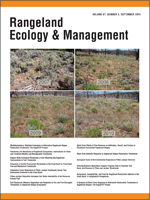As part of the Sagebrush Steppe Treatment Evaluation Project (SageSTEP), butterflies were surveyed pretreatment and up to 4 yr posttreatment at 16 widely distributed sagebrush steppe sites in the interior West. Butterfly populations and communities were analyzed in response to treatments (prescribed fire, mechanical, herbicide) designed to restore sagebrush steppe lands encroached by piñon-juniper woodlands (Pinus, Juniperus spp.) and invaded by cheatgrass (Bromus tectorum). Butterflies exhibited distinct regional patterns of species composition, with communities showing marked variability among sites. Some variation was explained by the plant community, with Mantel's test indicating that ordinations of butterfly and plant communities were closely similar for both woodland sites and lower-elevation treeless (sage-cheat) sites. At woodland sites, responses to stand replacement prescribed fire, clear-cutting, and tree mastication treatments applied to 10–20-ha plots were subtle: 1) no changes were observed in community structure; 2) Melissa blues (Plebejus melissa) and sulfurs (Colias spp.) increased in abundance after either burning or mechanical treatments, possibly due to increase in larval and nectar food resource, respectively; and 3) the juniper hairstreak (Callophrys gryneus) declined at sites at which it was initially present, probably due to removal of its larval food source. At sage-cheat sites, after prescribed fire was applied to 25–75-ha plots, we observed 1) an increase in species richness and abundance at most sites, possibly due to increased nectar resources for adults, and 2) an increase in the abundance of skippers (Hesperiidae) and small white butterflies. Linkages between woody species removal, the release of herbaceous vegetation, and butterfly response to treatments demonstrate the importance of monitoring an array of ecosystem components in order to document the extent to which management practices cause unintended consequences.
How to translate text using browser tools
1 September 2014
Short-Term Butterfly Response to Sagebrush Steppe Restoration Treatments
James McIver,
Euell Macke
cheatgrass
cut and leave
insect–plant relations
mastication
mowing
piñon-juniper
prescribed fire





